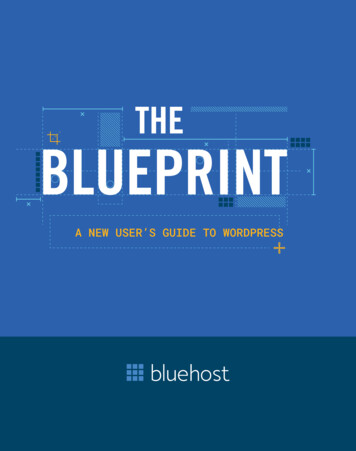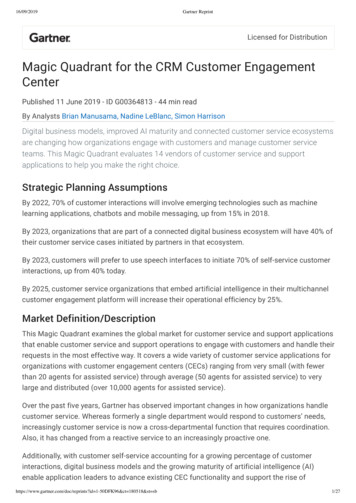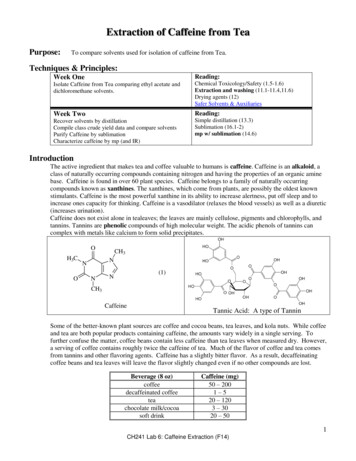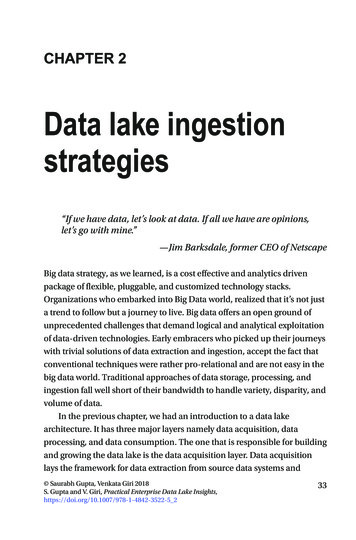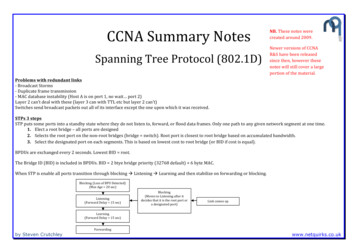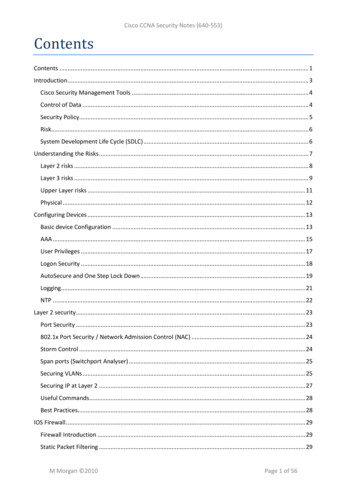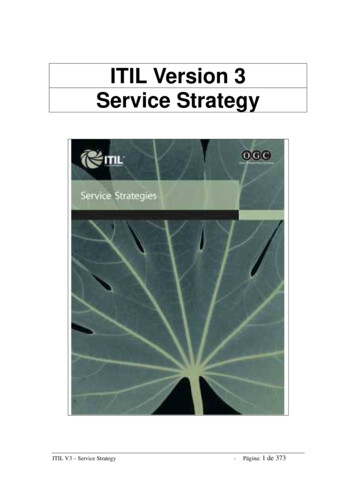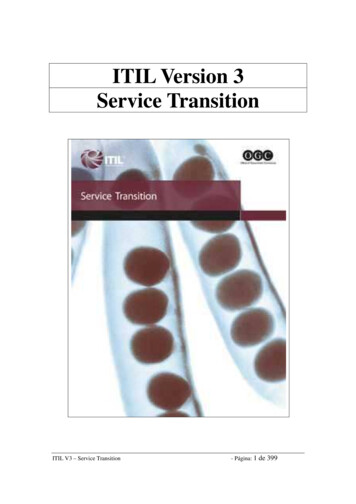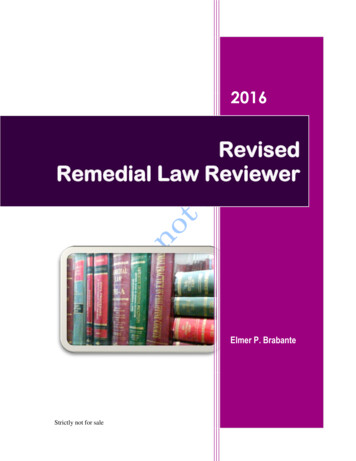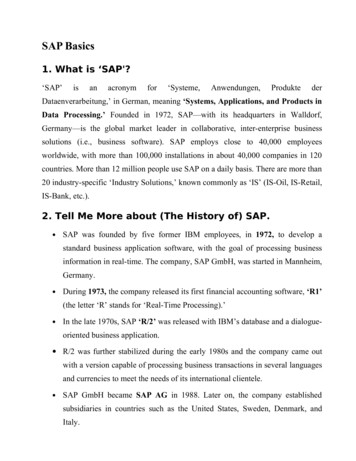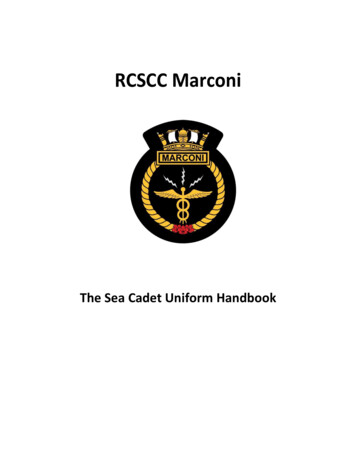
Transcription
Praise for Nathaniel Branden -andTIlE SIX PILLARS OF SELF-ESTEEM"Outstanding! Perhaps the most significant book ever written onself esteem."-Robert W. Reasoner, President, International Councilfor Self-Esteem"Nathaniel Branden is a giant in the field of self-esteem.The Six Pillars of Self-Esteem is a must-read for everyone."-Kenneth Blanchard, co-author of The One-Minute Manager"An invaluable contribution by a pioneer scholar of self-esteem."-Dr. Thomas Gordon, Founder, Parent Effectiveness Training (P.E.T.)"The Six Pillars of Self-Esteem is a masterpiece."-Warren Farrell,Ph.D., author of The Myth of Male Power"Clear, riveting, and profound. Nathaniel Branden reveals thepathways to actualizing and celebrating our remarkable selves."-Elaine Mazlish and Adele Faber, authors of How to Talk So Kids WillListen and Listen So Kids Will Talk and Siblings Without Rivalry"Among the clutter of management and how-to books,Dr. Branden's seminal work stands out like a beacon. Itdescribes the self-esteem connection between individual andorganizational success with the sharpness of a laser beam. It isnot only a must-read, but also a must-act-upon book."-Dick Sethi, Assistant Director, LeadershipDevelopment Program, AT&T"Nathaniel Brandep's new book is a masterpiece. It is a must forall of us who are still striving."-Charles "Red" Scott, Chairman Emeritus, Fuqua Industries Inc., and1984 recipient of the Horatio Alger Award of Distinguished Americans
T fSXPllRRSm . SElf-ESTEEm
.T fSXPllRRSOfj!,SElf-ESTEEm\'"Nathaniel BrandentBANTAMNEW YORKSYDNEYTORONTOAUCKlANDWNDON
THE SlXPlllAR. OF SELF-ESTEEMA Bantam BookPUBLISHING HISTORYBantam hardcover edition/March 1994Bantam trade paperback edition/June 1995All rights reserved.Copyright 1994 by Nathaniel Branden.Cover art copyright 1994 by One Plus One Studio.Book design by Kathryn PariseLibrary of Congress Catalog Card Number: 93-449l.No part of this book may be reproduced or transmittedin any fonn or by any means, electronic or mechanical,including photocopying, recording, or by any infonnationstorage and retrieval system, without pennission inwriting from tlie publisher.For iriformation address: Bantam Books.ISBN 0-553-37439-7Published simultaneously in the United States and CanadaBantam Books are published by Bantam Books, a division ofRandom House, Inc. Its trademark, consisting of the word "Bantam Books" and the portrayal of a rooster, is Registeredin U.S. Patent and Trademark Office and in other countries.Marca Registrada. Bantam Books, 1540 Broadway, New York,New York 10036.PRINTED IN mE UNrreD STATES OF AMERICABVG25 24
ContentsIIntroduction IxiPHRI I SHf-fSIHm ; BHSIC PRlnCIPlfSSelf-Esteem: The Immune System ofConsciousness I 3i\}I2 The Meaning of Self-Esteem I 263 The Face of Self-Esteem I 434 The Illusion of Self-Esteem I 49PHRI II5InlfRnH-L SOURCfS Of SHf-fSlHmThe Focus on ActionII 596 The Practice of Living Consciously II 677 The Practice of Self-Acceptance II 908 The Practice of Self-Responsibility I 1059 The Practice of Self-Assertiveness I 11710The Practice of Living Purposefully I 129II The Practice of Personal Integrity II 14312 The Philosophy of Self-Esteem II 160
VICOnTfnTSfX HRnRLin HUfn CfS : SHfR n0 0THfR SPRRT III13Nurturing a Child's Self-Esteem Self-Esteem in the Schools IIIS161118Self-Esteem and WorkII 171202II 227Self-Esteem and Psychotherapy II 256Self-Esteem and CultureII 277Conclusion: The Seventh Pillar of Self-Esteem II302RPPf n0IX R:Critique of Other Definitions ofSelf-Esteem II 305RPPf n0IX 0:A Sentence-Completion Exercise for BuildingSelf-Esteem II 309HPPf n0IXC:Recommendations for Further Study IIReferences II323AcknowledgmentsIndex II329II 327319
To Deve Branden
T f XPll R f. flf-f lffm
IntroductionMy purpose in this book is to identify, in greater depth and comprehensiveness than in my previous writings, the most important factors onwhich self-esteem depends. If self-esteem is the health of the mind, thenfew subjects are of comparable urgency.The turbulence of our times demands strong selves with a clear senseof identity; competence, and worth. With a breakdown of cultural consensus, an absence of worthy role models, little in the public arena toinspire our allegiance, .and disorientingly rapid change a permanentfeature of our lives, it is a dangerous moment in history not to know whowe are or not to trust ourselves. The stability we cannot find in the worldwe must create within our own persons. To face life with low self-esteemis to be at a severe disadvantage. These considerations are part of mymotivation in writing this book.In essence, the book consists of my answers to four questions: What isself-esteem? Why is self-esteem important? What can we do to raise thelevel of our self-esteem? What role do others play in influencing our selfesteem?Self-esteem is shaped by both internal and external factors. By "internal" I mean factors residing within, or generated by, the individualideas or beliefs, practices or behaviors. By "external" I mean factors inthe environment: messages·verbally or nonverbally transmitted, or experiences evoked, by parents, teachers, "significant others," organizations,and culture. I examine self-esteem from the inside and the outside: Whatis the contribution of the individual to his or her self-esteem and what is
XIIInTRODUCTIonthe contribution of other people? To the best of my knowledge, noinvestigation of this scope has been attempted before.When I published The Psychology of Self-Esteem in 1969, I told myselfI had said everything I could say on this subject. In 1970, realizing thatthere were "a few more issues" I needed to address, I wrote BreakingFree. Then, in 1972, "to fill in a few more gaps," I wrote The DisownedSelf. After that, I told myself I was absolutely and totally finished withself-esteem and went on to write on other subjects. A decade or sopassed, and I began to think abo,ut how much more I had personallyexperienced and learned about self-esteem since my first work, so Idecided to write "one last book" about it; Honoring ' the Self waspublished in 1983. A couple of years later I thought it would be useful towrite an action-oriented guide for in ividuals who wanted to work ontheir own self-esteem-How to Raise Your Self-Esteem, published in1986. Surely I had finally finished with this subject, I told myself. Butduring this same period, "the self-esteem movement" exploded acrossthe country; everyone was talking about self-esteem; books were written, lectures and conferences were given-and I was not enthusiasticabout the quality of what was being presented to people. I foundmyself in some rather heated discussions with colleagues. While someof what was offered on self-esteem was excellent, I thought that a gooddeal was not. I realized how many issues I had not yet addresseci, howmany questions I needed to consider that I had not considered before,and how much I had carried in my head but never actually said orwritten. Above all, I saw the necessity of going far beyond my earlierwork in spelling out the factors that create and sustain high or healthyself-esteem. (l use "high" and "healthy" interchangeably.) Once again, Ifound myself drawn back to examine new aspects of this inexhaustiblyrich field of study, and to think my way down to deeper levels of understanding of what is, for me, the single most important psychologicalsubject in the world.I understood that what had begun so many years before as an interest,or even a fascination, had become a mission.Speculating on the roots of this passion, I go back to my teenage years,to the time when emerging autonomy collided with pressure to conform.It is not easy to write objectively about that period, and I do not wish tosuggest an arrogance I did not and do not feel. The truth is, as anadolescent I had an inarticulate but sacred sense of mission about my life.I had the conviction that nothing mattered more than retaining the abilityto see the world through my own eyes. I thought that that was how
InTRODUCTion XIIIIeveryone should feel. This perspective has never changed. I was acutelyconscious of the pressures to "adapt" and to absorb the values of the"tribe"-family, community, and culture. It seemed to me that what wasasked was the surrender of my judgment and also my conviction that mylife and what I made of it was of the highest possible value. I saw mycontemporaries surrendering and losing their fire-and, sometimes inpainful, lonely bewilderment, I wanted to understand why. Why wasgrowing up equated with giving up? If my overriding drive since childhood was for understanding, another desire, hardly less intense, wasforming but not yet fully conscious: the desire to communicate myunderstanding to the world; above all, to communicate my vision of life.It was years before I realized that, at the deepest level, I experiencedmyself as a teacher-a teacher of values. Underneath all my work, thecore idea I wanted to teach was: Your life is important. Honor it. Fight foryour highest possibilities.I had my own struggles with self-esteem, and I give examples of themin this book. The .full context is given in my memoir, Judgment Day. Ishall not pretend that everything I know about self-esteem I learned frompsychotherapy clients. Some of the most important things I learned camefrom thinking about my own mistakes and from noticing what I did thatlowered or raised my own self-esteem. I write, in part, as a teacher tomyself.It would be foolish for me to declare that I have now written my finalreport on "the psychology of self-esteem." But this book does feel likethe climax of all the work that preceded it.I first lectured on self-esteem and its impact on love, work, and thestruggle for happiness in the late 1950s and published my first articles onthe subject in the 1960s. The challenge then was to gain public understanding of its importance. "Self-esteem" was not yet an expression inwidespread use. Today, the danger may be that the idea has becomefashionable. It is on everyone's tongue, which is not to say that it is betterunderstood. Yet if we are unclear about its precise meaning and aboutthe 'specific factors its successful attainment depends on-if we arecareless in our thinking, or succumb to the oversimplifications and sugarcoatings of pop psychology-then the subject will suffer a fate worsethan being ignored. It will become trivialized. That is why, in Part I, webegin our inquiry into the sources of self-esteem with an examination ofwhat self-esteem is and is not.
XIVInJ ROOUCTlOnWhen I first began struggling with questions concerning self-esteemforty years ago, I saw the subject as providing invaluabie clues to understanding motivation. It was 1954. I was twenty-four years of age, studyingpsychology at New York University, and with a small psychotherapypractice. Reflecting on the stories I heard from clients, I looked for acommon denominator, and I was struck by the fact that whatever theperson's particular complaint, there was always a deeper issue: a sense ofinadequacy, of not being "enough," a feeling of guilt or shame or inferiority, a clear lack of self-acceptance, self-trust, and self-love. In otherwords, a problem of self-esteem.In his early writings Sigmund Freud suggested that neurotic symptomscould be understood either as direct expressions of anxiety or else asdefenses against anxiety, which seemed to me to be a hypothesis of grearprofundity. Now I began to wonder if the complaints or symptoms Iencountered could be understood either as direct expressions of inadequate self-esteem (for example, feelings of worthlessness, or extremepassivity, or a sense of futility) or else as defenses against inadequate selfesteem (for example, grandiose bragging and boasting, compulsive sex,ual"acting-out," or overcontrolling social behavior). I continue to findthis idea compelling. Where Freud thought in terms of ego defensemechanisms, strategies to avoid the threat to the ego's equilibrium represented by anxiety, today I think in terms of self-esteem defense mechanisms, strategies to defend against any kind of threat, from any quarter,internal or external, to self-esteem or one's pretense at it). In otherwords, all the famous "defenses" that Freud identified can be understoodas efforts to protect self-esteem.When I went to the library in search of information about self-esteem,almost none was to be found. The indexes of books on psychology didnot contain the term. Eventually I found a few brief mentions, such as inWilliam James, but nothing that seemed suffiCiently fundamental or thatbrought the clarity I was seeking. Freud suggested that low "self-regard"was caused by a child's discovery that he or she could not have sexualintercourse with Mother or Father, which resulted in the helpless feeling,"I can do nothing." I did not find this persuasive or illuminating as anexplanation. Alfred Adler suggested that everyone starts out with feelingsof inferiority caused, first, by bringing some physical liability or "organinferiority" into the world, and second, by the fact that everyone else(that is, grown-ups or older siblings) is bigger and stronger. In otherwords, our misfortune is that we are not born as perfectly formed matureadults. I did not find this helpful, either. A few psychoanalysts wrote
InTRODUCTionxvabout self-esteem, but in terms I found remote from my understanding ofthe idea, so that it was almost as if they were studying another subject.(Only much later could I see some connection between aspects of thatwork and my own.) I struggled to clarify and expand my understandingchiefly by reflecting on what I observed while working with people.As the issue of self-esteem came more clearly into fOcus for me, I sawthat it is a profound and powerful human need, essential to healthyadaptiveness, that is, to optimal functioning and self-fulfillment. To theextent that the need is frustrated, we suffer and are thwarted in ourdeve
self-esteem and went on to write on other subjects. A decade or so passed, and I began to think abo,ut how much more I had personally experienced and learned about self-esteem since my first work, so I decided to write "one last book" about it; Honoring ' the Self was published in 1983. A couple of years later I thought it would be useful to write an action-oriented guide for in ividuals who .
